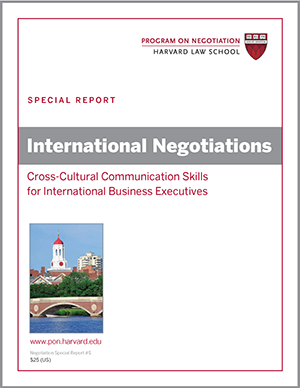
In an interesting example of negotiation team dynamics, during a 2018 New Year’s Day address, North Korean leader Kim Jong-un proposed opening talks with South Korea to discuss the North’s possible participation in the Winter Olympics, to be held in Pyeongchang, South Korea, the following month. Hoping to avoid disruption by the North, South Korean president Moon Jae-in had been calling on North Korea to send athletes to the Games. In his speech, Kim also touted the success of his country’s nuclear weapons program and threatened, “All of the mainland United States is within the range of our nuclear strike.”
Just a week later, negotiators from the North and South met on the countries’ shared border. There, the North agreed to the South’s request to send a large delegation to the Olympics. It was the first official dialogue between the two nations in two years.
Korea experts viewed the North’s overture as a “divide and conquer” strategy aimed at driving a wedge between South Korea and the United States, which had recently persuaded its allies to impose tough new sanctions on North Korea. Both the South Korean and U.S. governments insisted they were coordinating closely to minimize the security threat posed by North Korea. In fact, Moon credited then–U.S. president Donald Trump for instigating the negotiations between the two Koreas by pressuring the North with sanctions.
In negotiation, the “divide and conquer” strategy is rooted in the observation that when members of a negotiation team spend resources fighting one another, they will have fewer resources to use against their opposition, wrote Griffith University senior lecturer Larry Crump in a 2005 Negotiation Journal article.
Related to the biblical saying “a house divided against itself shall not stand,” the divide-and-conquer strategy is most relevant to competitions, contests, and distributive negotiations where each side is trying to “win.” But parties in integrative negotiations may also benefit from pitting factions within a counterpart’s negotiation team against one another.
Playing Offense
Among various types of negotiation skills, divide and conquer can be an effective strategy when you see value in negotiating with one faction on a counterpart’s negotiation team to the exclusion of others, exploiting differences between allied parties, or sowing discord among counterparts.
Here are a few hypothetical examples:
You’re negotiating with the sales, marketing, and IT departments of a large organization for a potential purchase. Believing you have a strong rapport with the lead IT negotiator, you try to negotiate with that person one-on-one with the hope of securing a favorable commitment.
A teenager detects that his parents have different views about his curfew despite their attempts to present a united front. When alone with his father, the teen talks about how eager he is to attend a late-night cast party and asks his dad to put in a good word with his mom.
After receiving mixed messages from two different members of a negotiation team, you angrily tell the one whose proposal you prefer that her counterpart is difficult to work with.
The key to implementing a divide-and-conquer strategy is to recognize that the interests and preferences of negotiation team members are often misaligned. One partner may have greater financial incentives to close a deal with you. One may have a stronger interest in building a long-term relationship with you. And one partner may have less motivation to get along well with her partner than the other person does. When you are having difficulty getting what you want from a negotiation, think about whether you can use such differences to your advantage, whether by shutting out one counterpart, encouraging a counterpart to influence her partner, or trying to drive a wedge between factions.
Playing Defense
How can you keep a counterpart from dividing and conquering your own negotiating team? Good defense depends on visionary leadership—particularly, your ability to keep your negotiation team unified and harmonious. Here are three negotiation skills to master:
1. Prepare thoroughly. The more time your negotiation team spends preparing to negotiate, the harder it will be for the other side to divide you. Before official negotiations begin, devote ample time to discussing the substance of the negotiation, assigning skills and roles, and planning the process with your team. Choose an overarching goal that will drive your negotiating strategy, such as reaching a deal that will contribute to your organization’s long-term health, and decide on fairness standards and decision-making rules for your group.
2. Anticipate conflict. Don’t assume your group will rise above any internal conflict that emerges during your negotiation. Discuss in advance how you will head off conflict or cope with it should it occur. Set regular times for the group to meet privately during the upcoming negotiation to discuss progress and potential “wedge” issues. Commit to discussing any differences that arise openly and respectfully.
3. Manage alliances. Internal coalitions can sink any negotiation team. For this reason, it’s important to be on the lookout for alliances that may develop and create disunity once negotiations get started. Crump recommends assigning a “link person” to be responsible for building and strengthening ties across negotiation team members. You can also reduce the odds that dysfunctional factions will form by meeting as a group whenever possible rather than caucusing separately.
Has your negotiation team successfully deployed a divide-and-conquer strategy? If so, what was the key to its success?






Negotiation can be tasking and time consuming. It required wide range of skills, including the three mentioned in the article to achieve the desired result. Divide and conquer strategy can’t provide result always but some of the times.